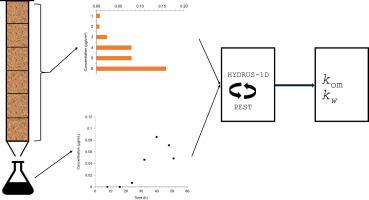土柱淋滤试验。导出环境命运参数的逆模型
Q2 Environmental Science
引用次数: 0
摘要
对于经合组织研究106中吸附性极低的物质,建议根据经合组织指南312进行柱淋溶研究。然而,由于溶质的突破,评价这些实验的方法往往不适用。因此,我们提出了一种新的评价方法,即利用HYDRUS-1D和PEST进行逆建模。以某样物质为例,不仅考虑了柱内最终浓度曲线,而且考虑了突破曲线。液相与固相有机质的分布系数在0.29 L/kg ~ 286 L/kg范围内,不确定度较小。与全局解算器(DREAM_ZS)的比较证实了该解的有效性。考虑到数值模拟和更可靠的参数估计(包括参数不确定性),该程序被建议用于确定目前无法在监管暴露评估中评估的化合物的吸附参数。本文章由计算机程序翻译,如有差异,请以英文原文为准。

Soil column leaching experiments – inverse modelling to derive environmental fate parameters
For substances with very low sorption in the OECD study 106, a column leaching study according to OECD Guideline 312 is recommended. However, the method to evaluate these experiments is often not applicable due to breakthrough of the solute. Therefore, we suggest a new evaluation procedure by inverse modelling with HYDRUS-1D and PEST. Using an example substance as a case study, not only the final concentration profiles in the column were considered but also the breakthrough curves. The distribution coefficients between the liquid and the organic matter in the solid phase were determined with soil-pH dependent results in the range of 0.29 L/kg – 286 L/kg with reasonably small uncertainties. Comparison with a global solver (DREAM_ZS) corroborated the solutions. This procedure is suggested to determine sorption parameters for compounds currently not possible to evaluate in regulatory exposure assessments, considering numerical simulations and more robust parameter estimation including parameter uncertainties.
求助全文
通过发布文献求助,成功后即可免费获取论文全文。
去求助
来源期刊

Environmental Advances
Environmental Science-Environmental Science (miscellaneous)
CiteScore
7.30
自引率
0.00%
发文量
165
审稿时长
12 weeks
期刊介绍:
 求助内容:
求助内容: 应助结果提醒方式:
应助结果提醒方式:


